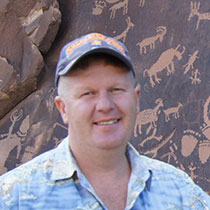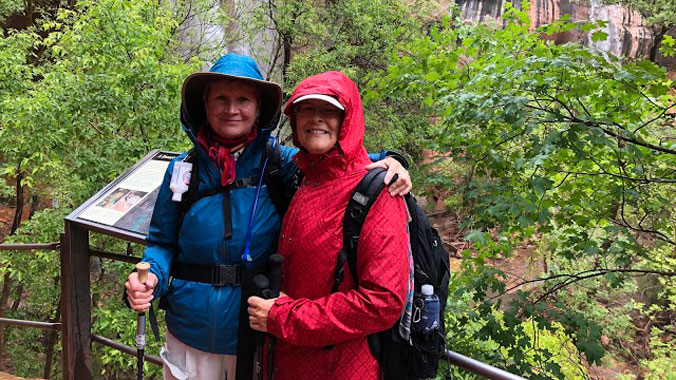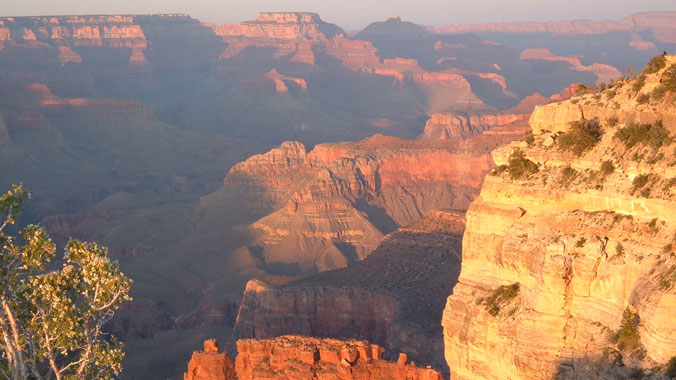A History of the Southwest: The Land and Its People
by Sheridan, Thomas
Something about the Southwest draws people who are independent. From the Apaches who migrated south six hundred years ago to the Spanish exploring north from Mexico not much later to the Anglo Americans who ventured west, these were people who wanted to live, as one Comanche leader said, "where the wind blows free and there is nothing to break the light of the sun." A History of the Southwest explores these people, their clashes with each other, with the environment, and finally with the forces of an increasingly complex economy. This book is a readable introduction to the history of the southwest people.
Ancient Landscapes of the Colorado Plateau
by Blakey, Ron and Wayne Ranney
The Colorado Plateau is one of the world's great showplaces of sedimentary, igneous, and metamorphic rock. The plateau's rocky landscapes are home to the greatest concentration of national parks and monuments in the world. Ancient Landscapes of the Colorado Plateau highlights the plateau's magnificent present through unique views of its fascinating past. It is a groundbreaking book featuring the geology of the American Southwest in a way you've never seen it before. This landmark book features more than 70 state-of-the-art paleogeographic maps of the region and of the world, developed over many years of geologic research. More than 100 full-color photographs, diagrams, and illustrations, this is a detailed guide of where to go to see the spectacular rocks of the region.
Beyond the Hundredth Meridian: John Wesley Powell and the Second Opening of the West
by Stegner, Wallace
Here Wallace Stegner, a Pulitzer Prize-winner, gives us a thrilling account of Powell's struggle against western geography and Washington politics. We witness the successes and frustrations of Powell's distinguished career, and appreciate his unparalleled understanding of the West. "Stegner's most exciting work." (San Francisco Chronicle)
496pp
Cadillac Desert: The American West and Its Disappearing Water
by Reisner, Marc
The story of the American West is the story of a relentless quest for a precious resource: water. It is a tale of rivers diverted and dammed, of political corruption and intrigue, of billion-dollar battles over water rights, of ecologic and economic disaster. In Cadillac Desert Marc Reisner writes of the earliest settlers, lured by the promise of paradise, and of the ruthless tactics employed by Los Angeles politicians and business interests to ensure the city's growth. He documents the bitter rivalry between two government giants, the Bureau of Reclamation and the U.S. Army Corps of Engineers, in the competition to transform the West. Based on more than a decade of research, Cadillac Desert is a stunning expose and a dramatic, intriguing history of the creation of an Eden--and Eden that may be only a mirage.
608pp
Carving Grand Canyon: Evidence, Theories, and Mystery
by Ranney, Wayne
Ranney explains how rivers in general can physically carve canyons, looks chronologically at the numerous theories that have been presented by successive generations of geologists regarding the Grand Canyon's formation, and describes a plausible sequence of geologic events that could create such a landscape. Numerous color photographs, detailed illustrations, and maps are provided. Annotation ©2005 Book News, Inc., Portland, OR 160pp; 2nd edition 2012.
Desert Solitaire
by Abbey, Edward
Edward Abbey's Desert Solitaire, the noted author's most enduring nonfiction work, is an account of Abbey's seasons as a ranger at Arches National Park outside Moab, Utah. Abbey reflects on the nature of the Colorado Plateau desert, on the condition of our remaining wilderness, and on the future of a civilization that cannot reconcile itself to living in the natural world.
Down the Great Unknown: John Wesley Powell's 1869 Journey of Discovery and Tragedy Through the Grand Canyon
by Dolnick, Edward
On May 24, 1869 a one-armed Civil War veteran, John Wesley Powell and a ragtag band of nine mountain men embarked on the last great quest in the American West. The Grand Canyon, not explored before, was as mysterious as Atlantis—and as perilous. The ten men set out from Green River Station, Wyoming Territory down the Colorado in four wooden rowboats. Ninety-nine days later, six half-starved wretches came ashore near Callville, Arizona.
Lewis and Clark opened the West in 1803, six decades later Powell and his scruffy band aimed to resolve the West’s last mystery. A brilliant narrative, a thrilling journey, a cast of memorable heroes—all these mark Down the Great Unknown, the true story of the last epic adventure on American soil.
Life in Stone: Fossils of the Colorado Plateau
by Sadler, Christa
Like pages in a book, the layers of sedimentary rock that are exposed on the Colorado Plateau tell us much about the diversity of environments that have come and gone over a period of hundreds of millions of years. This region is recognized as one of the finest earth-science laboratories in the world. Analysis of the fossil record and new discoveries across the plateau are answering questions, solving mysteries, and making connections that help us understand the history of life worldwide. "Life In Stone" tells the story of past environments and current discoveries with numerous illustrations and lively text written for a general audience.
72pp
Living at the Edge: Explorers, Exploiters, and Settlers of the Grand Canyon Region
by Anderson, Michael F
A comprehensive look at the pioneer history of the Grand Canyon Region, from its earliest residents to the creation of the national park at the end of the pioneer era (circa 1920). Included are close to two hundred historic photographs, many never published before, and 12 custom maps of the region. 184pp
Mormon Country
by Stegner, Wallace
Where others saw only sage, a salt lake, and a great desert, the Mormons saw their “lovely Deseret,” a land of lilacs, honeycombs, poplars, and fruit trees. Unwelcome in Ohio, Missouri, and Illinois, they migrated to the dry lands between the Rockies and the Sierra Nevada to establish Mormon country, a wasteland made green.
Like the land the Mormons settled, their habits stood in stark contrast to the frenzied recklessness of the American West. Opposed to the often prodigal individualism of the West, Mormons lived in closely knit – some say ironclad – communities. The story of Mormon country is one of self-sacrifice and labor spent in the search for an ideal in the most forbidding territory of the American West.
Native Roads : The Complete Motoring Guide to the Navajo and Hopi Nations
by Kosik, Frank
Using the mile markers of the US, Arizona, and Navajo highways and routes running through the Navajo and Hopi nations as her organizing principle, the author offers a travel guide to the sites found in the area. Natural, historical, and cultural points of interest are covered, along with some information on lodging and services. 280 pp
Roadside Geology of Arizona
by Chronic, Halka
The 18th printing of this book in the Roadside Geology Series offers a mini-course in geology, focusing on what can be seen from Arizona highways. Although written especially for those with little or no geologic training, there's plenty here for the professional geologist as well--a great introduction to Arizona and its past. Geologic terms are defined where first used and again in the glossary. Inside the front cover is a legend to geological symbols and abbreviations commonly used by geologists.
321pp
Roadside Geology of Utah
by Williams, Felicie, Lucy Chronic, and Halka Chronic
Arches National Park. Bryce Canyon. Zion. When one thinks of Utah, its rocks and iconic landforms preserved in a nearly endless list of national parks and monuments come immediately to mind. Perhaps more so than any other state, Utah is built for geologic exploration, and geologists/authors Felicie Williams, Lucy Chronic, and Halka Chronic are its expert tour guides.
The Beehive State is splitting at the seams with wondrous geological contrast. Utah's high mountains, showcasing the results of what happens as the Earth bends, folds, and breaks itself apart, run like a backbone down the center of the state. To the east, the Colorado Plateau's flat-lying sedimentary rock is wondrously exposed in canyons, arches, and breaks. To the west is the immense Great Basin, a region characterized by rank upon rank of long, narrow, gaunt mountain ranges alternating with desert basins that are among the flattest surfaces on Earth.
Roadside Geology of Utah's 65 road guides traverse the state's major thoroughfares as well as its dusty, sleepy, winding two-lane highways. With fresh prose and more than 300 color photos, maps, and figures to boot, you too will become expert at reading Utah's rocks.
Sedona Through Time: Geology of the Red Rocks
by Ranney, Wayne
Visitors to the towering red rock cliffs near Sedona seldom realize that the area was once a broad river floodplain that lay beyond the Ancestral Rocky Mountains. Or that this same place was later buried in a vast, Sahara-like desert, still later to lie beneath the waters of a warm tropical sea filled with ancient life forms. Sedona Through Time is an eminently readable story of the evolution of this fantastic landscape through the eons of geologic time.
Shadows of Time: The Geology of Bryce Canyon National Park
by Decourten, Frank
Shadows of Time is both a clearly written book about the geology of Bryce Canyon National Park, and a beautifully photographed look at the astonishing colors, textures and shapes of this landscape. If you enjoy the fantastic hoodoos and the trees that cling tot he rock ledges, you will love this book. The first section covers the geologic history of the Bryce Canyon area, and the second section highlights special things to see along eight of the most popular overlooks in the park.
The Emerald Mile: The Epic Story of the Fastest Ride in History Through the Heart of the Grand Canyon
by Fedarko, Kevin
In the spring of 1983, massive flooding along the length of the Colorado River confronted a team of engineers at the Glen Canyon Dam with an unprecedented emergency that may have resulted in the most catastrophic dam failure in history. In the midst of this crisis, the decision to launch a small wooden dory named “The Emerald Mile” at the head of the Grand Canyon, just fifteen miles downstream from the Glen Canyon Dam, seemed not just odd, but downright suicidal.
The Emerald Mile, at one time slated to be destroyed, was rescued and brought back to life by Kenton Grua, the man at the oars, who intended to use this flood as a kind of hydraulic sling-shot. The goal was to nail the all-time record for the fastest boat ever propelled—by oar, by motor, or by the grace of God himself—down the entire length of the Colorado River from Lee’s Ferry to Lake Mead. Did he survive? Just barely. Now, this remarkable, epic feat unfolds here, in The Emerald Mile.
The Glen Canyon Country: A Personal Memoir
by Fowler, Don D.
In his new book, The Glen Canyon Country, archaeologist Don D. Fowler shares the history of a place and the peoples who sojourned there over the course of several thousand years. To tell this story, he weaves his personal experience as a student working on the Glen Canyon Salvage Project with accounts of early explorers, geologists, miners, railroad developers, settlers, river runners, and others who entered this magical place. The book details the canyon’s story via historical and scientific summaries, biographical sketches, personal memoir, and previously unpublished photos of the land and its explorers. Readers will experience the intrigue and beauty of the Canyon while following not only the story of an individual but also of Glen Canyon itself. Infused with the breadth and depth of a lifetime of archaeological experience, The Glen Canyon Country is the definitive account of the prehistory and history of a significant river corridor and the surrounding land.
The Southwest
by Lavender, David
First published in 1980 as part of Harper & Row's Regions of America series, this lively account is now available only from the University of New Mexico Press. Focusing on New Mexico and Arizona, it also touches on neighboring states Texas, Colorado, Utah, Nevada, and California, as well as northern Mexico. Lavender writes of the Southwest from the time of the earliest Indian inhabitants to the eras of the Spanish conquerors, the French fur trappers, and the eventual expansion of the United States into the area. He describes conflicts between Mexico and Spain, Mexico and Texas, and Mexico and the United States and explores the truth behind folklore and legends about cowboys, Indians, and outlaws. He also discusses the region's present-day problems--the difficulties of relationships among a variety of racial, cultural, and economic groups and the scarcity of usable land, water, and air.
Water, Rock & Time: The Geologic Story of Zion National Park
by Eves, Robert L.
This long-awaited book by Dr. Robert Eves, professor of geology at Southern Utah University, tells the story of the formation of Zion Canyon in 132 pages, and contains more than 120 of the most inspiring photos of Zion National Park ever published. This is one of Zion Natural History Association's most popular publications.
Where the Sky Touched the Earth: The Cosmological Landscapes of the Southwest
by Lago, Don
The landscapes of the American Southwest - the Grand Canyon, Monument Valley, the Sedona red rocks - have long filled humans with wonder about nature. This is the home of Lowell Observatory, where astronomers first discovered evidence that the universe is expanding; Meteor Crater, where Apollo astronauts trained for the moon; and Native American tribes with their own ancient, rich ways of relating to the cosmos. With the personal, poetic style of the very best literary nature writing, Don Lago explores how these landscapes have offered humans a deeper sense of connection with the universe. While most nature writing never leaves the ground, Lago is one of the few writers who has applied it to the universe, seeking ties between humans and the astronomical forces that gave us birth.
Nowhere else in the world is the link between earth and sky so powerful. Lago witnesses a solar eclipse over the Grand Canyon, climbs primeval volcanos, and sees the universe in tree rings. Through ageless Native American ceremonies, modern telescopes, and even dreams of flying saucers, Lago, who is not only a poet but a true philosopher of science, strives to find order and meaning in the world and brings out the Southwest's beauty and mystery.














